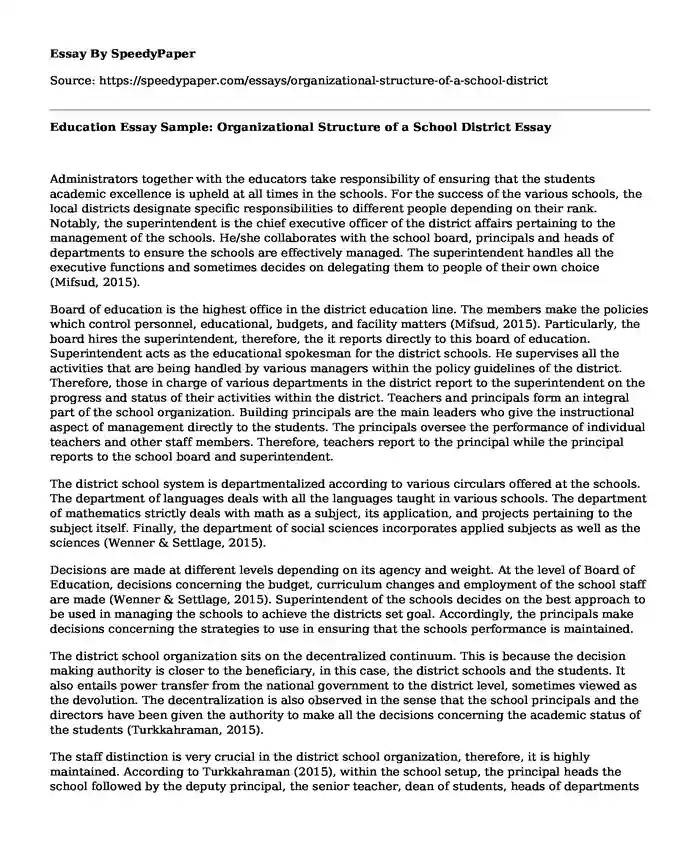
| Type of paper: | Essay |
| Categories: | Leadership analysis Education School |
| Pages: | 3 |
| Wordcount: | 643 words |
Administrators together with the educators take responsibility of ensuring that the students academic excellence is upheld at all times in the schools. For the success of the various schools, the local districts designate specific responsibilities to different people depending on their rank. Notably, the superintendent is the chief executive officer of the district affairs pertaining to the management of the schools. He/she collaborates with the school board, principals and heads of departments to ensure the schools are effectively managed. The superintendent handles all the executive functions and sometimes decides on delegating them to people of their own choice (Mifsud, 2015).
Board of education is the highest office in the district education line. The members make the policies which control personnel, educational, budgets, and facility matters (Mifsud, 2015). Particularly, the board hires the superintendent, therefore, the it reports directly to this board of education. Superintendent acts as the educational spokesman for the district schools. He supervises all the activities that are being handled by various managers within the policy guidelines of the district. Therefore, those in charge of various departments in the district report to the superintendent on the progress and status of their activities within the district. Teachers and principals form an integral part of the school organization. Building principals are the main leaders who give the instructional aspect of management directly to the students. The principals oversee the performance of individual teachers and other staff members. Therefore, teachers report to the principal while the principal reports to the school board and superintendent.
The district school system is departmentalized according to various circulars offered at the schools. The department of languages deals with all the languages taught in various schools. The department of mathematics strictly deals with math as a subject, its application, and projects pertaining to the subject itself. Finally, the department of social sciences incorporates applied subjects as well as the sciences (Wenner & Settlage, 2015).
Decisions are made at different levels depending on its agency and weight. At the level of Board of Education, decisions concerning the budget, curriculum changes and employment of the school staff are made (Wenner & Settlage, 2015). Superintendent of the schools decides on the best approach to be used in managing the schools to achieve the districts set goal. Accordingly, the principals make decisions concerning the strategies to use in ensuring that the schools performance is maintained.
The district school organization sits on the decentralized continuum. This is because the decision making authority is closer to the beneficiary, in this case, the district schools and the students. It also entails power transfer from the national government to the district level, sometimes viewed as the devolution. The decentralization is also observed in the sense that the school principals and the directors have been given the authority to make all the decisions concerning the academic status of the students (Turkkahraman, 2015).
The staff distinction is very crucial in the district school organization, therefore, it is highly maintained. According to Turkkahraman (2015), within the school setup, the principal heads the school followed by the deputy principal, the senior teacher, dean of students, heads of departments and other subjects teachers in that line. The distinction also applies when it comes to the management of the entire district school system. The superintendent tops the staff as the oversight officer on all schools in the district, the school board members, the principal and the teachers follow in the distinction chain as outlined.
References
Mifsud, D. (2015). Circulating Power and In/Visibility: Layers of Educational Leadership. Journal of Workplace Learning, 27(1), 51-67
Turkkahraman, M. (2015). Education, Teaching and School as a Social Organization. Procedia - Social and Behavioral Sciences, 186(The Proceedings of 5th World Conference on Learning, Teaching and Educational Leadership), 381-387. doi:10.1016/j.sbspro.2015.04.044
Wenner, J. A., & Settlage, J. (2015). School Leader Enactments of the Structure/Agency Dialectic via Buffering. Journal of Research in Science Teaching, 52(4), 503-515.
Cite this page
Education Essay Sample: Organizational Structure of a School District. (2020, Nov 26). Retrieved from https://speedypaper.net/essays/organizational-structure-of-a-school-district
Request Removal
If you are the original author of this essay and no longer wish to have it published on the SpeedyPaper website, please click below to request its removal:
- Free Essay: Christian Actions on Environment Preservation and Restoration
- Free Essay Sample: Microsoft as a Marketing Success
- Essay Sample on YAY Bale Wrap
- Essay Sample Dedicated to Digital Marketing in Africa
- Political Science Essay Sample: Hume and Fielding on Liberty
- The Odyssey Book XI Close Reading and Critical Analysis Essay Sample
- Essay Example on Restoration and 18th Century Literature
Popular categories




